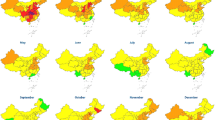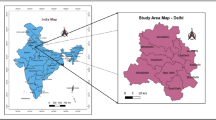Abstract
The environmental decision-making process is preceded by data analysis, which is conditioned by a specific temporal and spatial scale. Air quality management decisions are different from a regional to local and very local spatial frame, and from hourly or daily patterns, according to the different types of air pollution sources, different meteorological conditions and different pollutant characteristics. This paper aims to present a methodology that integrates the time-space framework of air quality data to infer the temporal pattern and spatial variability that could be interpreted for environmental decision purposes. Variograms that accommodate time and space lags were used for the analysis and proved to be effective. Temporal and spatial trends were found for data collected on an hourly and daily basis and its environmental meaning is discussed. Visualization of spatial patches of air pollution in Lisbon during a working day is performed through the use of an image processing technique, named morphing. Scientific visualization has becoming a very powerful approach to explore and understand data, mainly, spatio-temporal data.
Access this chapter
Tax calculation will be finalised at checkout
Purchases are for personal use only
Preview
Unable to display preview. Download preview PDF.
Similar content being viewed by others
References
Anselin, L. (1993) Exploratory Spatial Data Analysis and Geographic Information Systems DOSES Workshop on Spatial Analysis and GIS Lisboa.
Anselin, L. (1994) Local indicators of spatial association-LISA, Research Paper 9331, Regional Research Institute, West Virginia University.
Becker, R., A., Eick, S. G., Wilks, A. R. (1995) Visualizing Network Data, IEEE Transactions on Visualization and Computer Graphics 1, I, pp. 16–28.
Cressie, N., (1991) Statistics for Spatial Data, John Wiley and Sons, Inc., New York.
DeJong, S. M., and Burrough, P. (1995). A Fractal approach to the classification of mediterranean vegetation types in remotely sensed images, Photogrametric Engineering and Remote Sensing, 61, 8, pp. 1041–1053.
Getis, A. and J. K. Ord, (1992) The Analysis of Spatial Association by Use of Distance Statistics, Geographycal Analysis, 24, 3, pp. 189–206.
Isaacs, E. and Srivastava., R. (1989) An Introduction to Applied Geostatistics,. Oxford University Press, New York.
Miller, E. (1996), Towards a Four-Dimensional GIS: Four-Dimensional Interpolation Utilizing Kriging, GIS Research UK, University of Canterbury.
Rhyne, T., Bolstad, M., Rheingans, P. (1993) Visualizing Environmental Data at the EPA, IEEE Transactions on Visualization and Computer Graphics 13, 2, pp. 34–38.
Seixas, J. (1996) Exploratory spatial-time data analysis: the case of desertification, accepted for the 2nd ESFNSF GISDATA Summer Institute, Berlin, 24 July-1 August.
Senay, H., E. Ignatius, (1994) A knowledge-based System for Visualization Design, IEEE Transactions on Visualization and Computer Graphics 14, 6, pp. 36–47.
Soares, A., Tâvora, J., Pinheiro, L., and Almeida, J. (1993) Predicting Probability Maps of Air Pollution Concentration: A Case Study on Barreiro/Seixal Industrial Area, Geostatistics Troia’92, Ed. Amilcar Soares, Klywer Academic Publishers, Holland, pp. 625–636.
Wolberg, G.(1988) Digital Image Warping,IEEE Computer Society Press Monograph.
Author information
Authors and Affiliations
Editor information
Editors and Affiliations
Rights and permissions
Copyright information
© 1997 Springer Science+Business Media Dordrecht
About this paper
Cite this paper
Seixas, J., Ferreira, F., Nunes, C., Silva, J.P. (1997). Space-Time Analysis of Air Pollution in Lisbon. In: Soares, A., Gómez-Hernandez, J., Froidevaux, R. (eds) geoENV I — Geostatistics for Environmental Applications. Quantitative Geology and Geostatistics, vol 9. Springer, Dordrecht. https://doi.org/10.1007/978-94-017-1675-8_33
Download citation
DOI: https://doi.org/10.1007/978-94-017-1675-8_33
Publisher Name: Springer, Dordrecht
Print ISBN: 978-90-481-4861-5
Online ISBN: 978-94-017-1675-8
eBook Packages: Springer Book Archive




